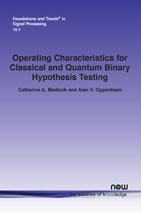Operating Characteristics for Classical and Quantum Binary Hypothesis Testing
By Catherine A. Medlock, Massachusetts Institute of Technology, USA, cmedlock@mit.edu | Alan V. Oppenheim, Massachusetts Institute of Technology, USA, avo@mit.edu
Abstract
This monograph addresses operating characteristics for binary hypothesis testing in both classical and quantum settings and overcomplete quantum measurements for quantum binary state discrimination. We specifically explore decision and measurement operating characteristics defined as the tradeoff between probability of detection and probability of false alarm as parameters of the pre-decision operator and the binary decision rule are varied. In the classical case we consider in detail the Neyman-Pearson optimality of the operating characteristics when they are generated using threshold tests on a scalar score variable rather than threshold tests on the likelihood ratio. In the quantum setting, informationally overcomplete POVMs are explored to provide robust quantum binary state discrimination. We focus on equal trace rank one POVMs which can be specified by arrangements of points on a sphere that we refer to as an Etro sphere.
Operating Characteristics for Classical and Quantum Binary Hypothesis Testing
Binary decisions guide our everyday lives in situations both critical and trivial. The choices made by politicians and physicians may have consequential implications on a global or individual scale. Perhaps less consequential is whether or not we choose to carry an umbrella on a cloudy day. Any choice made inherently involves a conscious, subconscious, or formal tradeoff between benefits and detriments.
This monograph develops and presents a framework for binary hypothesis testing as it applies to both the classical and quantum mechanical environments. The authors set the scene by first describing separately the operating characteristics associated with classical binary hypothesis testing and those within quantum mechanics. They proceed to describe in detail in subsequent chapters how quantum measurements that employ redundant, or overcomplete, representations of the state of the system being measured can be used.
Written in a tutorial style, readers from both classical and quantum backgrounds will find this an enlightening treatise on the topic. Examples and problems are used throughout to enable the reader to readily grasp the new concepts and to further their own understanding. This monograph is a comprehensive and accessible overview of a complex problem for students and researchers in signal processing.
